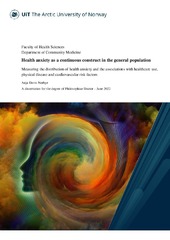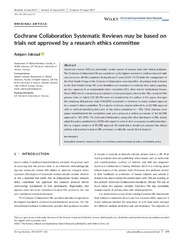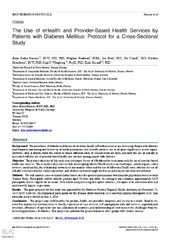| dc.contributor.advisor | Ringberg, Unni | |
| dc.contributor.author | Norbye, Anja Margrete Davis | |
| dc.date.accessioned | 2022-10-20T05:55:49Z | |
| dc.date.available | 2022-10-20T05:55:49Z | |
| dc.date.issued | 2022-11-07 | |
| dc.description.abstract | <p><i>Background:</i> Health anxiety (HA) concerns worry of disease, and has mostly been examined in people with severe HA/hypochondriasis. However, HA can be conceptualised as a continuous construct, with levels ranging from low to severe. There is little knowledge on the distribution of HA as a continuous construct in the general population, nor the association between different levels of HA and healthcare use, physical disease and cardiovascular risk factors.
<p><i>Aim:</i> To study the distribution of HA as a continuous construct in the general population, examine sociodemographic and social network factors associated with HA, and examine the association between HA and healthcare use, physical disease and cardiovascular risk factors.
<p><i>Methods:</i> This thesis used cross-sectional data from the Tromsø study: Tromsø7 (2015-2016). 21 083 persons aged 40 years or older gave self-reported information on physical diseases, cardiovascular risk factors, and healthcare use in the last 12 months. HA was measured with Whiteley Index; possible scores ranged from 0-24. Sociodemographic and social network factors included age, gender, education, household income, friendship, and participation in organised activities.
<p><i>Results:</i> HA was highly skewed in our sample of the general adult population, with an exponential distribution. Of the sociodemographic and social network variables, friendship had the highest association with HA level. HA as a continuous construct was associated with increased level of use of all types of healthcare services. HA was also consistently higher in the population reporting current or previous physical disease and cardiovascular risk factors, than in the healthy reference group.
<p><i>Conclusion:</i> Our results support conceptualising HA as a continuous construct. Mean HA in the study sample was low, but all levels of HA were associated with increased healthcare use. Having physical disease and cardiovascular risk factors were consistently associated with increased HA. This indicates that all levels of HA deserve attention in future research. | en_US |
| dc.description.abstract | <p><i>Bakgrunn:</i> Forskning på temaet helseangst (HA) har i stor grad fokusert på alvorlig helseangst; personer som har symptombyrde likt de med hypokondri. HA er samtidig foreslått som et kontinuerlig fenomen, med alvorlighetsgrader som varierer fra lite til alvorlig. Alvorlig, eller høy grad av HA, er assosiert med høyt helsetjenesteforbruk og redusert livskvalitet. HA som et kontinuerlig fenomen har vi lite kunnskap om, heller ikke hvordan dette fordeler seg i den generelle befolkningen. I Norge og i verden er helsetjenesteforbruk økende, sammen med økende forekomst av fysisk sykdom og kardiovaskulære risikofaktorer. Sammenhengen mellom HA som et kontinuerlig fenomen og disse faktorene er derfor viktig å undersøke.
<p><i>Formål:</i> Formålet med denne doktorgraden var å undersøke fordelingen av HA som et kontinuerlig fenomen i en voksen, generell befolkning, samt undersøke hvordan ulike faktorer var assosiert med HA; sosiodemografiske og sosiale faktorer, ulike typer helsetjenesteforbruk, fysisk sykdom og kardiovaskulære risikofaktorer.
<p><i>Metode:</i> Doktorgraden brukte spørreskjemadata fra 21 083 personer som var 40 år eller eldre, som deltok på Tromsøundersøkelsen (Tromsø7) i 2015-2016, og hadde et tverrsnittdesign. HA ble målt med to versjoner av måleverktøyet Whiteley Index (WI-6 og WI-6-R), med en totalscore 0 til 24 der høyere score indikerer høyere HA. Sosiodemografiske faktorer inkluderte alder, kjønn, utdanning, husholdningsinntekt, vennskap og deltakelse i organisert aktivitet. Helsetjenesteforbruk inkluderte bruk av primærhelsetjenesten, somatisk spesialisthelsetjeneste og psykiatrisk spesialisthelsetjeneste de siste 12 måneder. Deltakerne rapporterte også om de hadde ulike somatiske sykdommer, nå eller tidligere, og om de hadde kardiovaskulære risikofaktorer.
<p><i>Resultat:</i> HA var skjevfordelt i den generelle voksne befolkningen og hadde en eksponentiell fordeling. Av de sosiodemografiske variablene var vennskap den variabelen som var sterkest assosiert med HA. Alle grader av HA var assosiert med alle typer helsetjenesteforbruk. Grad av HA var gjennomgående høyere hos deltakere med fysisk sykdom sammenlignet med deltakere uten sykdom. Dette gjaldt både personer med nåværende og tidligere sykdom, samt de med kardiovaskulære risikofaktorer.
<p><i>Konklusjon:</i> Våre resultater, med utgangspunkt i Tromsø7, viser HA som et kontinuerlig fenomen. Selv om gjennomsnittsscoren av HA var lav, var alle grader av HA assosiert med helsetjenesteforbruk. Sammenhengen mellom HA og fysisk sykdom var også konsekvent. Jeg mener våre funn indikerer at alle grader av HA er viktig og fortjener økt oppmerksomhet, både i fremtidig forskning og klinisk praksis. | en_US |
| dc.description.doctoraltype | ph.d. | en_US |
| dc.description.popularabstract | Health anxiety (HA) concerns worry about disease, and this thesis perceives HA as a range from mild worry to excessive anxiety. The aim of this thesis was to study the distribution of HA in the general population, and to examine the relationship between HA, healthcare use, physical disease and cardiovascular risk factors. I used quantitative data from the Tromsø study: Tromsø7 (2015-2017). 21 083 persons aged 40 years or older gave self-reported information on physical diseases, cardiovascular risk factors and their healthcare use. HA was measured with the questionnaire Whiteley Index. The results showed that most people had low levels of HA. All levels of HA were associated with higher healthcare use, and people with current and previous disease as well as cardiovascular risk factors had higher HA than the healthy reference group. This indicates that all levels of HA deserve attention, both in research and clinical practice. | en_US |
| dc.description.sponsorship | Internal funding by UiT The Arctic University of Norway | en_US |
| dc.identifier.uri | https://hdl.handle.net/10037/27090 | |
| dc.language.iso | eng | en_US |
| dc.publisher | UiT The Arctic University of Norway | en_US |
| dc.publisher | UiT Norges arktiske universitet | en_US |
| dc.relation.haspart | <p>Paper 1: Norbye, A.D., Abelsen, B., Førde, O.H. & Ringberg, U. (2020). Distribution of health anxiety in a general population and associations with demographic and social network characteristics. <i>Psychological Medicine, 52</i>(12), 2255-2262. Also available in Munin at <a href=https://hdl.handle.net/10037/20269>https://hdl.handle.net/10037/20269</a>.
<p>Paper 2: Norbye, A.D., Abelsen, B., Førde, O.H. & Ringberg, U. (2022). Health anxiety is an important driver of healthcare use. <i>BMC Health Services Research, 22</i>(1), 138. Also available in Munin at <a href=https://hdl.handle.net/10037/24571>https://hdl.handle.net/10037/24571</a>.
<p>Paper 3: Norbye, A.D., Abelsen, B., Førde, O.H. & Ringberg, U. (2022). The association between health anxiety, physical disease and cardiovascular risk factors in the general population – a cross-sectional analysis from the Tromsø study: Tromsø 7. <i>BMC Primary Care, 23</i>(1), 140. Also available in Munin at <a href=https://hdl.handle.net/10037/27084>https://hdl.handle.net/10037/27084</a>. | en_US |
| dc.rights.accessRights | openAccess | en_US |
| dc.rights.holder | Copyright 2022 The Author(s) | |
| dc.rights.uri | https://creativecommons.org/licenses/by-nc-sa/4.0 | en_US |
| dc.rights | Attribution-NonCommercial-ShareAlike 4.0 International (CC BY-NC-SA 4.0) | en_US |
| dc.subject | VDP::Medical disciplines: 700::Health sciences: 800::Community medicine, Social medicine: 801 | en_US |
| dc.subject | VDP::Medisinske Fag: 700::Helsefag: 800::Samfunnsmedisin, sosialmedisin: 801 | en_US |
| dc.subject | VDP::Medical disciplines: 700::Health sciences: 800::Epidemiology medical and dental statistics: 803 | en_US |
| dc.subject | VDP::Medisinske Fag: 700::Helsefag: 800::Epidemiologi medisinsk og odontologisk statistikk: 803 | en_US |
| dc.subject | VDP::Medical disciplines: 700::Health sciences: 800::Health service and health administration research: 806 | en_US |
| dc.subject | VDP::Medisinske Fag: 700::Helsefag: 800::Helsetjeneste- og helseadministrasjonsforskning: 806 | en_US |
| dc.subject | VDP::Social science: 200::Psychology: 260::Other psychology disciplines: 279 | en_US |
| dc.subject | VDP::Samfunnsvitenskap: 200::Psykologi: 260::Andre psykologiske fag: 279 | en_US |
| dc.subject | Tromsøundersøkelsen | en_US |
| dc.subject | The Tromsø Study | en_US |
| dc.title | Health anxiety as a continuous construct in the general population - measuring the distribution of health anxiety and the associations with healthcare use, physical disease and cardiovascular risk factors | en_US |
| dc.type | Doctoral thesis | en_US |
| dc.type | Doktorgradsavhandling | en_US |


 English
English norsk
norsk



